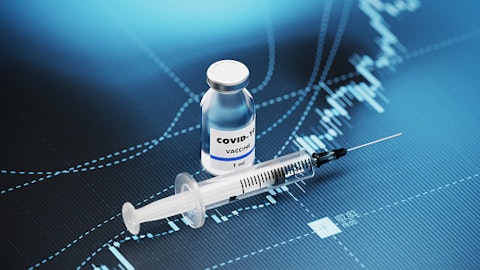With regard to PNP, I’ll just frame it up with what we are looking to do and how you may want to think about the profile, and then I’ll turn it over to Stuart for commercialization. The Phase 2 study, that’s the study we have completed and expect to share the results before the end of this year. It is a study that has a Lyrica reference arm. So it’s not a comparison, but it’s there so that we can assess the magnitude of the treatment effect. And our goal here really is to have a medicine that can compete effectively and bring a better benefit risk profile than Lyrica for this patient population. And just so that it’s not missed, one of the comments I made in my prepared remarks is we’re now expanding our progress into the peripheral neuropathic pain area with a study that we will initiate before end of year in what’s called LFR or lumbosacral radiculopathy, another kind of neuropathic pain.
Stuart?
Stuart Arbuckle: Yeah, just to expand on that, Robyn, very briefly. So PNP is kind of an umbrella term which is used to describe a collection of conditions, all which have — as their cause nerve impairment which causes pain. DPN, which as you know is the study which is ongoing with 548, obviously there the standard of care has been the gabapentinoids, and as Reshma said, what we’re looking to do there, because there are approved therapies there which are generic, is demonstrate an improved benefit risk profile to be able to compete successfully in that market segment. And Phase 2 studies obviously are going to be very revealing in that regard. LSR is very different — and DPN I should say accounts for about 20% of all patients in the US with PMP.
That’s 20% of approximately 10 million people. LSR accounts for over 40% of patients with PNP. There, there are no products which are specifically approved for LSR. So we see that as a very significant opportunity as well. They are obviously with no approved therapy, it’s likely that the comparator is going to be, can we demonstrate effective pain relief versus placebo?
Robyn Karnauskas: And one follow-up I can. Do you have to look better? I know Lyrica is just a side arm, but I know a lot of doctors want it looking better for reimbursement. Do you have to look better or just safer? We obviously know the issues with safety with Lyrica.
Reshma Kewalramani: Yeah. The point you make about the safety tolerability issues with Lyrica are real. What we’re looking for in this Phase 2 program is change from baseline at the various doses with Lyrica as a reference arm, not a comparator. But our goal here to be clear is to have a product, VX-548, that is a better benefit risk profile than Lyrica.
Robyn Karnauskas: Great. Thanks, guys.
Operator: The next question will come from Salveen Richter with Goldman Sachs. Please go ahead.
Salveen Richter: Good afternoon. Thanks for taking my questions. One here on the pain side with the LSR trial, can you help us understand why start this trial now versus waiting for the DPN trial to read out and get a better understanding of the profile there? And then a second question on the Cells and Device program here, that seems to be partial dose with staggered enrollment again. And I’m just wondering why in the context of maybe the de-risking that you saw in the naked cells approach? Thank you.
Reshma Kewalramani: Sure. Thanks. Let me start with the VX-264 question, and I’ll go back to pain. The reason that we are at a partial dose with staggered dosing in the Part A part of the 264 program is because the cells + device is a first in man program. And we are doing that to go slowly and ensure that we have sufficient time between patients to be able to assess safety. And it is the way that the protocol is designed in consultation with global regulators. So that’s the reason, it’s because cells + device is a first in man trial. Let me go back now to VX-548 and LSR and why now? It’s really a very good question. The reason we started with DPN is because DPN or diabetic peripheral neuropathy has and has had an established regulatory pathway, as well as an established commercial marketplace.





